Expert after expert continually tells Hamilton to make its downtown streets safe and walkable, but we prioritize automobile through traffic over all other concerns.
By Ryan McGreal
Published March 28, 2012
In 2008, the City of Hamilton's Public Works Department held its first annual Transportation Summit, a one-day conference to present best practices and innovative strategies on developing the city's transportation system.
This year's summit takes place on Thursday, April 5, 2012. The theme is "Exploring Complete Streets", or streets that are designed to accommodate pedestrians, cyclists, transit users and drivers alike in a safe and accessible manner.
It features talks by former Madison Wisconsin mayor Dave Cieslewicz, pedestrian planner Peter Lagerwey and transportation engineer Norma Moores, and either a workshop on designing complete streets or an "infrastructure walkabout".
I don't know if I can bear to attend.
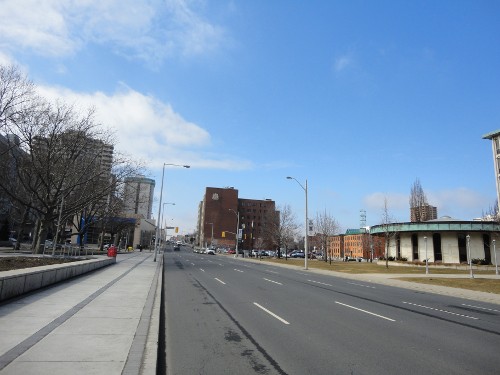
Main Street: five-lane, one-way expressway cuts through downtown
I went to the first transportation summit in 2008, and came away inspired by the exciting talks by traffic engineers and planners bluntly and unequivocally telling the attendees: convert your streets back to two-way, widen the sidewalks, plant street trees, add bike lanes, build light rail transit.
I remember being particularly impressed by the traffic engineer who explained that the city's efforts to improve air quality by making traffic flow more efficiently - timed lights, turn lanes and so on - are actually counter-productive. When it's easier to drive, more people drive longer distances more frequently and the overall air pollution goes up.
If it wasn't so easy to drive long distances quickly, people would make different decisions about where to live and where to shop. Entrepreneurs would make different decisions about where to invest and businesses would make different decisions about where and how to locate. In a positive feedback loop, the cumulative effect of those decisions would serve to make walking, cycling and transit more effective and viable.
Unfortunately, none of it seemed to make much of a difference. Despite the traffic engineers and planners telling councillors and Public Works managers and staff that the city needs to convert its downtown streets back to two-way, that option has always been off the table.
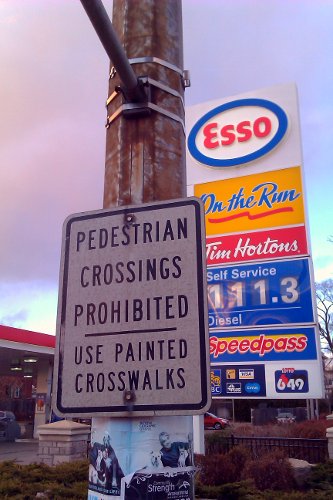
Pedestrian Crossings Prohibited sign at King and Dundurn
RTH contributor Nicholas Kevlahan attended the 2009 Summit and wrote about his frustration over the mismatch between the event's message of sustainability and balance and the institutional reality of a city that is steadfastly committed to maximizing traffic flow.
[I]n both the Cycle Plan and LRT presentations, staff highlighted the fact that decisions were constrained by the need to maximize traffic flow.
This was completely at odds with other presentations that showed how high traffic volumes have all sorts of deleterious effects (pollution, high social costs due to accidents, expressways like King/Main killing commerce), but staff just can't seem to accept that maximizing traffic flow should not be a primary goal (perhaps, not even a goal at all).
They left the impression that improved service for pedestrians, cyclists and transit should be allowed only if they don't significantly impact traffic. This is both self-contradictory (it is, at least partly, a zero sum game), and unfair (why aren't the interests of all road users given equal consideration?).
We're hearing the same message in our economic summits as we hear in our transportation summits. At last year's Hamilton Economic Summit, keynote speaker Christopher Leinberger talked about the role of walkable streets in foster economically successful cities.
The year before, Storm Cunningham made a similar argument in favour of dense, lively downtown neighbourhoods, particularly through adaptive reuse of old properties. Cunningham, in turn, was exploring the same arguments made at the 2008 Economic Summit by keynote speaker Richard Florida.
In fact, every time a group of urban planners comes to Hamilton, they tell us the same thing: one-way streets and through truck traffic create "patches of despair" that are "killing the city".
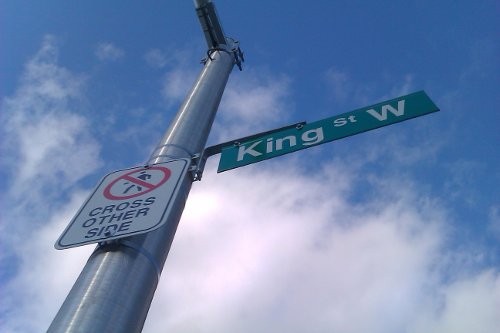
No pedestrian crossing sign at King and Pearl
We've been listening to experts tell us to convert our streets back to two-way since before 2008. In 2006, Public Works organized a pedestrian workshop featuring a keynote and workshop with a pedestrian planning expert who recommended all the usual things: convert traffic to two-way, install a network of bike lanes, plant a canopy of street trees.
Then the Public Works managers got up and said there was no way Main Street was going to be converted back to two-way: it carries too many cars. Well, yes, that's kind of the problem.
A year before that, Donald Schmitt, the architect whose firm designed McMaster Innovation Park, gave a talk on how Hamilton can spur revitalization by designing livable streets. In an interview with RTH, he explained:
Two way streets slow cars down. The environment on the sidewalk, particularly if they are widened with parallel parking and street trees becomes more protected from traffic and more conducive to window shopping, outdoor food and sidewalk life.
Pedestrians cross the street more safely and both sides of the street start to work together as a true retail strip.
Looking at Hamilton, he noted:
In an era when Canadian downtowns in Montreal, Vancouver and Toronto are bursting with vitality, Hamilton has too many abandoned buildings, too many narrow sidewalks, too few trees on the street.
Take a couple of traffic lanes, widen the sidewalks, give more comfort to the pedestrian. If people linger, low rents will attract small businesses, small galleries, shops and cafes.
The energy of those small business people will begin to restore vitality to the street.
As far back as September 1996, a Downtown Ideas Charette organized by a group of Hamilton architects, planners, developers, and engineers produced a list of recommendations that looks depressingly familiar:
That was over 15 years ago, and the efficient movement of traffic is still taking precedence over other objectives.
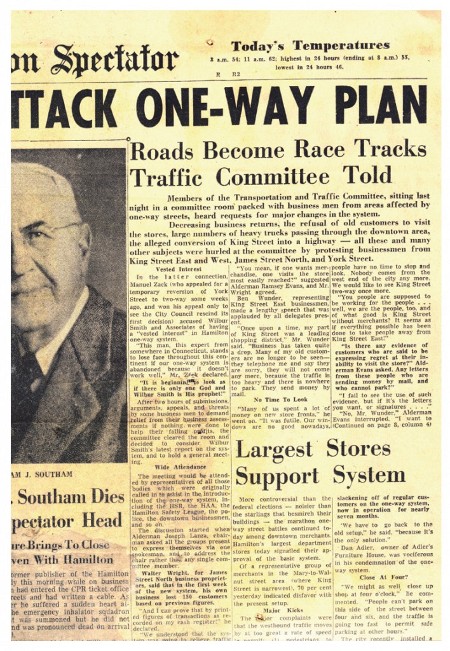
1957 Spectator article: 'Roads Become Race Tracks, Traffic Committee Told'
It gets worse. Local opposition to the one-way conversion of Hamilton's downtown streets started when the streets were converted in the first place. Here's a Spectator report on a traffic committee meeting just seven months after the streets were converted overnight in October 1956:
Ben Wunder, representing King Street East businessmen, made a lengthy speech that was applauded by all delegates present.
"Once upon a time, my part of King Street was a leading shopping district," Mr. Wunder said. "Business has taken quite a drop. Many of my old customers are no longer to be seen - they telephone me and say they are sorry, they will not come any more, because the traffic is too heavy and there is nowhere to park. They send money by mail.
"Many of us spent a lot of money on new store fronts," he went on. "It was futile. Our windows are no good nowadays, people have no time to stop and look. Nobody comes from the west end of the city any more. We would like to see King Street two-way once more."
We ignored this central, inescapable fact back in 1956, and we're still ignoring it today.
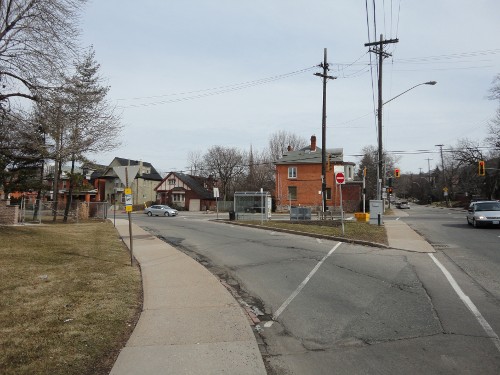
Highway-style on-ramp at Queen and Aberdeen
Despite decades of recommendations and mountains of evidence, the city continues to sacrifice downtown revitalization to the all-important goal of optimizing through traffic flow.
We saw it when Council rejected the Downtown BIA's plea to stop transport trucks from blasting through downtown on Main Street.
We saw it when staff dropped the plan to convert Main Street to two-way as part of the east-west LRT plan - despite the fact that the city's own consultants and even Metrolinx argued that LRT will be more successful with two-way streets. The decision was made on the basis of maintaining traffic flow:
We are not currently proposing to convert Main Street to two-way traffic. There is still a need for some traffic to move easterly across the City, and Main Street fulfills this role.
It doesn't matter how many other cities, both large and small, commit to making their downtown streets walkable and almost immediately enjoy big improvements in vitality and livability.
In Hamilton, the smooth flow of traffic trumps all other concerns. Not even clear evidence of danger to children is enough to shake our steadfast commitment to the fast, efficient flow of large numbers of vehicles through our struggling urban neighbourhoods.

Sign by Paul Sousa: City of Hamilton - Designed so you can drive like no one lives here!
This coming Thursday, when another bevy of experts comes to Hamilton to tell our transportation planners the exact same thing they've heard steadily for years, are they suddenly going to be persuaded to change their priorities and commit to making Main Street Street, King Street, Cannon Street, Bay Street and our other struggling thoroughfares safe and walkable?
I would fall over myself to attend a Transportation Summit if I thought it would produce a real transformation in the City's priorities away from automobile flow-through to embrace making streets livable instead.
However, it would be deeply depressing to commit a full day of listening to expert after expert tell us to convert our streets to two-way and redesign them to be safe and livable for pedestrians and cyclists, only to have our leaders discard it all when it comes to the overarching sanctity of traffic flow.
By jason (registered) | Posted March 28, 2012 at 13:19:51
I'm with you. These events are just a smokescreen. A few days of good press once a year so that average citizens think that we are actually moving forward with 21st Century (or late 20th Century) ideas.
We aren't.
It's 2012 and there still isn't a single bike lane route that one could ride from Gage Park to McMaster.
All of these summits and conferences are a complete waste of time....they'll be looked back upon in 20 years with the same wishful thinking that we all view the Vision 2020 documents with - what could have been if we had some leadership or vision.
By Pxtl (registered) - website | Posted March 28, 2012 at 13:25:52
I just want to show people something - this is a major intersection in Brantford I noticed when I was in town for a baptism:
http://maps.google.com/maps?q=google+map...
At first glance, it could be in Hamilton - it's a wide, massive intersection with a highway-style slit to allow traffic to flow around the corner, unimpeded.
But look closer - even though this is a major intersection adjascent to a bridge over the Grand River (which produces the same "cut the city in half" problem as our escarpment) we have crosswalks on every side of the intersection. No "Pedestrian Crossing Prohibited". And, more importantly, look around that highway-style ramp. There are "YIELD TO PEDESTRIANS" signs with warning lights on them.
And this isn't in Stockholme or Paris or London. It's not Toronto or New York City. It's an economically depressed post-industrial town in Southern Ontario a half-hour away.
I mean, I want our intersections and roads to look like those in Portland and Amsterdam and Copenhagen. But at this point I'd settle for Brantford.
This is pathetic.
By jason (registered) | Posted March 28, 2012 at 13:53:38 in reply to Comment 75516
we could never do that in Hamilton because...
I just covered all the responses that your idea would receive from Public Works and CHML.
Just saving everyone some time.
Comment edited by jason on 2012-03-28 13:55:22
By jason (registered) | Posted March 28, 2012 at 14:02:05 in reply to Comment 75520
Hey, a roundabout worked well near the mega Walmart in Ancaster. Why not downtown in a pedestrian oriented research park??
By Pxtl (registered) - website | Posted March 28, 2012 at 14:35:45 in reply to Comment 75520
If highway-ramps on corners make an intersection better, then the roundabout is the objectively perfect intersection - it's an intersection entirely composed of highway-ramps.
By Lakeside (registered) | Posted March 28, 2012 at 14:46:03
The local traffic planners here are past-master at maximizing the flow of motorized traffic. Now if they could just learn to speak the language of Complete Streets with the same fluency, how long would it take before they're at the top of that game, too?
Surely the McMaster Institute for Transportation & Logistics is teaching the latest global best practices, right?
Trying, perhaps desperately, to be optimistic here. Could the recent retirement of Hart Solomon possibly bring some change to the prevailing mode of thinking at Transport?
Reading the news, I haven't noticed anything about the appointment of a successor. Could it be that they're having trouble finding a qualified unilingual candidate, who only speaks vehicular flow?
By jackson (anonymous) | Posted March 28, 2012 at 15:29:37
it's time for some direct action. Can we get some of those satire signs conspicuously placed around the summit?
By Train track (anonymous) | Posted March 28, 2012 at 17:05:34
The "on Ramp" that you refer to in the article is in fact a vestige of the Old radial rail line that once ran from Terminal Towers downtown all the way to Downtown Brantford. The road alignment at that intersection was the place where the tracks crossed queen and Aberdeen and then continued northeast toward Hess Street. There is a house and an apartment building now where the tracks once traversed the block between Queen and Hess.
This line and one from Dundas, Oakville and Vineland once brought people and produce right into our once vibrant downtown.
By DrAwesomesauce (registered) | Posted March 28, 2012 at 21:21:10 in reply to Comment 75526
And we blew all those radial lines up. It's a terrible shame. How awesome would it be to take a train from downtown to Vineland??
If you want to know the problem, just look to the big players in this city. A lot of them are in the logistics/transportation field, suburban homebuilding, auto parts, etc. These guys have serious pull down at City Hall. End of story.
By sjkiss (registered) | Posted March 28, 2012 at 21:31:42
I agree with Ryan's dismal assessment; I actually thought that the Open Streets launch last June that I attended served a similar purpose. Everybody drove to the Liuna station, talked about all the great projects were were doing to revitalize the city, then had our picture taken in front of a bus that had to be specially diverted there because, of course, the HSR doesn't actually go to LIUNA regularly and we all had our picture taken for the city's propaganda purposes.
But, ignoring these things altogether is also not the greatest. But I think we need to kick it up a notch, I liked what someone suggested above about spreading the satire signs. Let's make fun of the process, make it an embarrassment, rather than a propaganda tool, for the city. Anyway, just a thought.
By arienc (registered) | Posted March 28, 2012 at 23:12:14
While they're at it, maybe our traffic planners can ignore this video as well.
After all, we can't possibly be deserving of having this here...
By highwater (registered) | Posted March 29, 2012 at 09:11:08 in reply to Comment 75533
Ok, I've been a little obsessed with school closure stuff lately, so forgive me for putting a school closure spin on a fun radial line fact, but several years ago when the board wanted to shutter Dundana School, one of the rationales they used was the fact that it was dangerous because it was so close to train tracks. Problem was, it was actually the radial trail. No one from the board had bothered to come out to see if there was an actual working line there before making their pronouncement.
By moylek (registered) - website | Posted March 29, 2012 at 09:45:50 in reply to Comment 75536
uber-canonical geeks
I'm at a loss. I'm a geek by vocation and a word guy by avocation, but I really can't figure out what 'uber-canonical' means in a general sense, and certainly not what makes a geek not merely a canonical one, but over and above canonical.
Comment edited by moylek on 2012-03-29 09:47:56
By Today (anonymous) | Posted March 29, 2012 at 11:49:36
Doesn't really fit in here but thought I'd post at any rate. I hate how these stereotypes of Hamilton still exist among southern Ontarians. Someone from the Waterloo region:
"I went instead to Detroit. I’m not sure if I’ve ever been in a place, not even Hamilton, that had so much to show me about the momentum of loss."
http://www.therecord.com/living/travel/article/689694--detroit-unsightly-for-sore-eyes
By Today (anonymous) | Posted March 29, 2012 at 14:00:25 in reply to Comment 75545
Yes, that's correct Ryan noticing this now as you say. Well I suppose he is calling it like it is then in that case.
By totally awesome (anonymous) | Posted March 29, 2012 at 20:50:53 in reply to Comment 75529
I like the sound of taking a train from downtown to vineland. Maybe we could get 4 or even 5 people together to do it. What would the cost be then? no more than a few grand each right?
By jmorse (registered) | Posted March 29, 2012 at 21:53:59
There is hope. We await the arrival of the one that will bring balance to mainstream discourse in Hamilton. It will reveal the secrets. It will break down weak arguments. It will give a voice to the voiceless. It will have journalistic integrity. It's arrival is imminent. It is the CBC. We are saved!
By Shempatolla (registered) - website | Posted March 29, 2012 at 22:29:10
This is going to have to start with the citizenry through mediums like this informing each other and then holding our elected officials to account. Most of them only care about reelection unfortunately so holding their feet to the electoral fire is one of the few things that work. If enough people in enough wards (particularly downtown) get the message through that 1950s era expressways through our city center are no longer acceptable, maybe we will see some change. I will email my councillor tonight with respect to this conference in April.
By DowntownInHamilton (registered) | Posted March 30, 2012 at 07:29:44 in reply to Comment 75529
If you had the rarely-used tracks in, you could say goodbye to the rail trail that runs between Dundas and the west end (it actually links up to Brantford an onwards in the West). I actually went to Dundana as a kid and walked a stretch of the rail trail daily to get to school. I remember seeing trains run along there very, very, infrequently, and I remember them ripping out the tracks and putting in the crushed gravel to make a walking path.
TBH, there's really nothing in Vineland I couldn't do without, and what I can, I will simply drive in my car to see.
By perfect (anonymous) | Posted March 31, 2012 at 02:55:00 in reply to Comment 75557
By moylek (registered) - website | Posted March 31, 2012 at 14:14:59 in reply to Comment 75607
What cities with more snow and ice like than Hamilton have this great cycling culture?
Montreal. And it's built on the side of mountain. And Montreal drivers are famously aggressive.
They but in good bike lanes and an extensive system of rental bikes - and the lanes and the rental bikes are all very well used.
I've said it before: if Montreal can become a cycling city, Hamilton sure has hell can.
By jason (registered) | Posted March 31, 2012 at 18:04:10 in reply to Comment 75607
Ummm, you're talking about density and weather (notwithstanding your mailman's opinion) to justify the lack of cycling? How about this: Snowy, hilly Montreal. Rainy, hilly Portland. Check out their core city densities too. This isn't difficult. It's all about priorities and city leadership/vision.
Comment edited by jason on 2012-03-31 18:04:50
By TB (registered) - website | Posted April 01, 2012 at 08:45:05
By perfect (anonymous) | Posted April 01, 2012 at 11:56:07 in reply to Comment 75608
By perfect (anonymous) | Posted April 01, 2012 at 12:00:41 in reply to Comment 75559
you are absolutely right! the problem is most and more likely the vast majority of the populace just does not give a rats behind about bike lanes, or bike assists up the hill. You are going to have trouble finding support for HSR among the general population. So maybe the masses should unite and hold their feet to the political fire until we get our way and stop wasting time and money on these useless projects and start ticketing bikes for running stop signs and riding on the sidewalk.
By arienc (registered) | Posted April 01, 2012 at 19:21:38 in reply to Comment 75607
By DrAwesomesauce (registered) | Posted April 01, 2012 at 22:08:01 in reply to Comment 75615
Ahhhh okay...so we should 'get' all that stuff and then it'll be fine to paint a few lines on the street? You're obviously a dude who's spent very little time downtown.
You're right about one thing, though: most Hamiltonians do think the way you do which is why so many young, intelligent people flee the city every year.
'Very little of Europe has winters as cold, snowy and icy as ours are.'
Come on, dude. 9C / 3C are the highs and lows for Copenhagen today. It's cold, snowing and plenty icy in Denmark, Holland and the rest of Northern Europe where cycling is used as a daily means of transport in many places.
You don't like cycling. You don't like cities. We get it. Move on.
By Shempatolla (registered) - website | Posted April 02, 2012 at 17:15:19 in reply to Comment 75616
My major concern is not about bike lanes, bike lifts etc. My concern is making my city livable instead of an inconvenient place that gets in the way of automobiles. Two way conversion to at least parts of King and Main Sts as well as continuing the two way of Cannon west to James would go a long way towards that. Along with revisiting and revising the ridiculous set back by laws in the planning department which is nothing but an impediment to development downtown.
I work in downtown Toronto, I'm on the streets every day. Two way streets foster economic activity, grow the tax base and make the neighbourhoods they pass through livable, attracting younger, professional people with discretionary income to spend who want to live there. OH MY GOD HOW AWFUL WOULD THAT BE?
The two expressways we have running through our downtown have led to a a very visible division between have and have nots, have contributed to the economic malaise that has helped decay our urban core for my lifetime.
Einstein said the definition of insanity is doing the same thing over and over again and expecting a different result. Clearly continuing to put the car before people has not had the result we all hope for.
How are we going to convince the powers that be that logic need be applied and that they need to do what we know needs to get done..
put the damn streets back to two way and give us back our downtown ~!
By DrAwesomesauce (registered) | Posted April 04, 2012 at 23:14:24 in reply to Comment 75572
Radial TRAILS are a poor replacement for radial LINES.
By my suggestion (anonymous) | Posted April 09, 2012 at 20:42:55
If you hate Hamilton the way it is so much move to Portland, Toronto, Copenhagen or whatever utopia you believe exists.
You must be logged in to comment.
There are no upcoming events right now.
Why not post one?